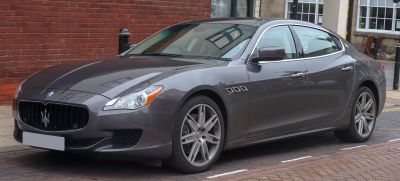Maserati Quattroporte

- Year: 1963
- Body Type: 4-door sedan
- Price: ₹1.80 - ₹2.32 Cr
The Maserati Quattroporte, a flagship sedan embodying Italian luxury and performance, has long been synonymous with refined power and sophisticated style. Its elegant proportions and assertive stance immediately command attention. Powered by either a potent V6 or V8 engine, the Quattroporte delivers impressive acceleration and a smooth, refined driving experience. The interior is a meticulously crafted space, characterized by luxurious materials, such as high-quality leather and fine wood trim, creating a truly opulent atmosphere. Technology is seamlessly integrated, offering advanced features while maintaining an air of understated elegance. The Quattroporte offers ample rear passenger space and a large trunk, making it a practical choice for those seeking a luxurious and capable four-door vehicle. Its blend of power, luxury, and sophisticated Italian design solidify its position as a true grand tourer.
Generations
Quattroporte I (AM107, 1963–1969)
The Maserati Quattroporte I (AM107, 1963-1969) was a groundbreaking car, marking the beginning of Maserati’s foray into the luxury four-door sedan market. Designed by Carrozzeria Frua, its sleek lines and elegant styling established a design language that would influence future generations of Quattroportes. Mechanically, it offered a choice of potent V8 engines, delivering a thrilling combination of luxury and performance previously unseen in this segment. Its handcrafted nature and use of high-quality materials emphasized the brand's commitment to luxury and craftsmanship. The AM107 quickly gained a reputation for its graceful handling and impressive power, solidifying its place as a desirable and iconic grand tourer. This first Quattroporte set the stage for a legacy of performance-oriented luxury sedans.
Quattroporte II (AM123, 1974–1978)
The Maserati Quattroporte II (AM123, 1974-1978) represented a more powerful and refined iteration of its predecessor. While retaining the elegance of the original, this generation featured updated styling by Giorgetto Giugiaro, featuring sharper lines and a more assertive stance. Under the hood, larger capacity V8 engines provided even more exhilarating performance. The Quattroporte II maintained its focus on handcrafted quality, using premium materials throughout the interior. Although production numbers were relatively low compared to some competitors, its potent engine, sophisticated handling, and enduring design ensured its place as a coveted classic Maserati. This generation cemented the Quattroporte's reputation as a desirable high-performance luxury sedan, albeit one produced in more limited numbers than the current iterations.
Quattroporte III/Royale (AM330, 1979–1990)
The Maserati Quattroporte III/Royale (AM330), produced from 1979 to 1990, represented a significant shift for the marque, moving away from the overtly sporty handling of its predecessors towards a more luxurious and comfortable grand tourer. While still utilizing a powerful V8 engine (initially a 4.2L and later a 4.9L), the focus shifted to refined performance and opulent interiors. This generation is characterized by its distinctive, angular styling, a departure from the more curvaceous lines of its ancestor. The Royale variant, introduced later in the production run, featured an even more luxurious interior and a longer wheelbase for enhanced rear passenger space, further emphasizing its role as a sophisticated flagship sedan. Despite its age, the AM330 remains a highly collectible example of Italian automotive artistry, prized for its blend of power, comfort, and timeless elegance. Mechanically, it was relatively robust, but parts sourcing can now be challenging for owners.
Quattroporte IV (AM337 1994–2001)
The Maserati Quattroporte IV (AM337), launched in 1994 and produced until 2001, marked a return to more traditionally Italian design language with its smoother, more flowing lines. This generation saw a significant technical upgrade, notably the adoption of a potent 3.2L V8 (later upgraded to a 4.0L V8) offering substantial power and a more refined driving experience compared to its predecessor. The AM337 maintained the focus on luxury, offering opulent interiors and a refined ride, but with a sportier feel that balanced comfort with performance more effectively than the AM330. While still offering a considerable amount of power, the AM337 aimed for a more balanced driving experience, suitable for both high-speed cruising and spirited driving. Its design, while aging gracefully, retains a certain timeless elegance, showcasing Maserati's commitment to blending power and style.
Quattroporte V (M139, 2003–2012)
The Maserati Quattroporte V (M139), built from 2003 to 2012, represented a substantial leap forward for the brand. Designed under the watchful eye of Giorgetto Giugiaro, its styling was contemporary and striking, setting a new benchmark for Maserati's design language. This generation offered a range of engines, including a Ferrari-derived V8, showcasing a clear performance focus. The M139 also incorporated advancements in technology and comfort features, including updated electronics and refined interiors. The chassis was significantly improved, enhancing both handling and ride quality, creating a grand tourer that offered a thrilling driving experience without compromising luxury. It represented a modern interpretation of the Quattroporte legacy, successfully blending power, elegance, and contemporary technology. This generation is often praised for its balanced character and lasting design.
Quattroporte VI (M156, 2013–2023)
The Maserati Quattroporte VI (M156), produced from 2013 to 2023, marked a significant evolution in terms of size, technology, and styling. Designed under the leadership of Lorenzo Ramaciotti, it presented a more aggressive and muscular design, departing from the more refined elegance of its predecessors. This generation benefited from advancements in platform technology, offering a more refined driving experience and improved handling. A range of powerful engines, including V6 and V8 options, ensured plenty of performance. The interior was notably luxurious, showcasing high-quality materials and advanced technology features. The M156 aimed for a more technologically advanced and powerful driving experience compared to previous generations, reflecting the evolving landscape of the luxury car market, and ultimately proving a successful sales platform for Maserati.